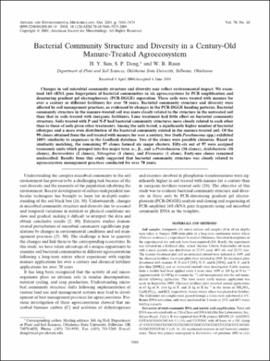| dc.contributor.author | Sun, H. Y. | |
| dc.contributor.author | Deng, S. P. | |
| dc.contributor.author | Raun, W. R. | |
| dc.date.accessioned | 2018-08-29T14:24:31Z | |
| dc.date.available | 2018-08-29T14:24:31Z | |
| dc.date.issued | 2004-10 | |
| dc.identifier | oksd_sun_bacterialcommun_2004 | |
| dc.identifier.citation | Sun, H. Y., Deng, S. P., & Raun, W. R. (2004). Bacterial community structure and diversity in a century-old manure-treated agroecosystem. Applied and Environmental Microbiology, 70(10), 5868-5874. https://doi.org/10.1128/AEM.70.10.5868-5874.2004 | |
| dc.identifier.uri | https://hdl.handle.net/11244/301606 | |
| dc.description.abstract | Changes in soil microbial community structure and diversity may reflect environmental impact. We examined 16S rRNA gene fingerprints of bacterial communities in six agroecosystems by PCR amplification and denaturing gradient gel electrophoresis (PCR-DGGE) separation. These soils were treated with manure for over a century or different fertilizers for over 70 years. Bacterial community structure and diversity were affected by soil management practices, as evidenced by changes in the PCR-DGGE banding patterns. Bacterial community structure in the manure-treated soil was more closely related to the structure in the untreated soil than that in soils treated with inorganic fertilizers. Lime treatment had little effect on bacterial community structure. Soils treated with P and N-P had bacterial community structures more closely related to each other than to those of soils given other treatments. Among the soils tested, a significantly higher number of bacterial ribotypes and a more even distribution of the bacterial community existed in the manure-treated soil. Of the 99 clones obtained from the soil treated with manure for over a century, two (both Pseudomonas spp.) exhibited 100% similarity to sequences in the GenBank database. Two of the clones were possible chimeras. Based on similarity matching, the remaining 97 clones formed six major clusters. Fifty-six out of 97 were assigned taxonomic units which grouped into five major taxa: a-, B-, and y-Proteobacteria (36 clones), Acidobacteria (16 clones), Bacteroidetes (2 clones), Nitrospirae (1 clone), and Firmicutes (1 clone). Forty-one clones remained unclassified. Results from this study suggested that bacterial community structure was closely related to agroecosystem management practices conducted for over 70 years. | |
| dc.format | application/pdf | |
| dc.language | en_US | |
| dc.publisher | American Society for Microbiology | |
| dc.rights | This material has been previously published. In the Oklahoma State University Library's institutional repository this version is made available through the open access principles and the terms of agreement/consent between the author(s) and the publisher. The permission policy on the use, reproduction or distribution of the material falls under fair use for educational, scholarship, and research purposes. Contact Digital Resources and Discovery Services at lib-dls@okstate.edu or 405-744-9161 for further information. | |
| dc.title | Bacterial community structure and diversity in a century-old manure-treated agroecosystem | |
| osu.filename | oksd_sun_bacterialcommun_2004.pdf | |
| dc.description.peerreview | Peer reviewed | |
| dc.identifier.doi | 10.1128/AEM.70.10.5868-5874.2004 | |
| dc.description.department | Plant and Soil Sciences | |
| dc.type.genre | Article | |
| dc.type.material | Text | |
| dc.subject.keywords | bacteria | |
| dc.subject.keywords | base sequence | |
| dc.subject.keywords | dna fingerprinting | |
| dc.subject.keywords | genetic variation | |
| dc.subject.keywords | phylogeny | |
| dc.subject.keywords | soil microbiology | |
| dc.subject.keywords | time factors | |
